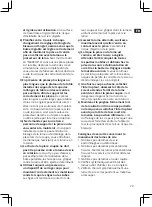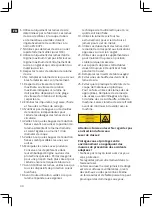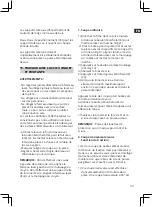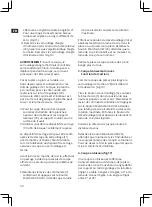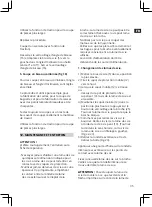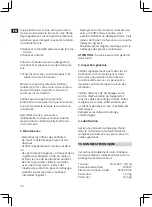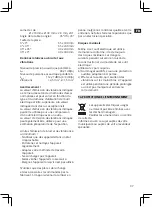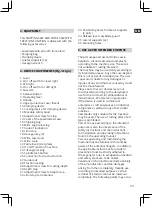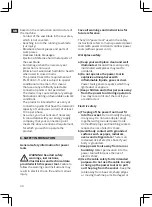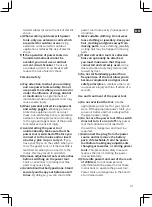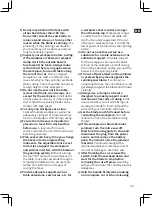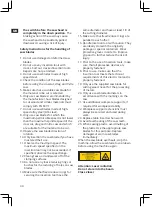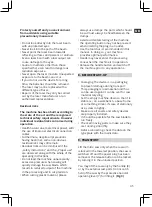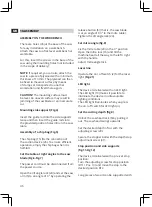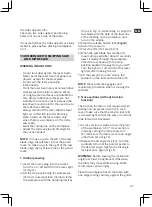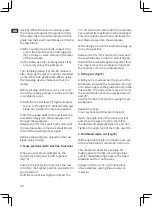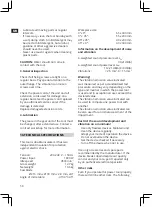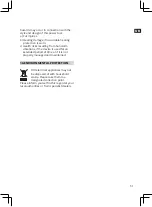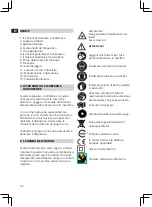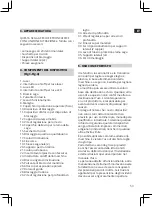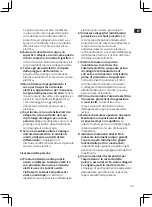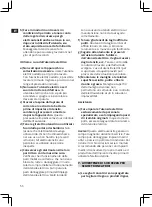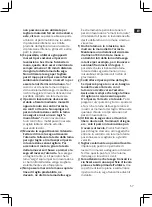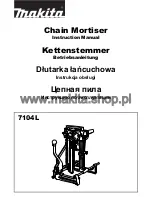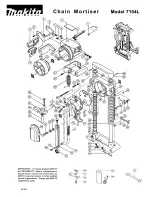
42
e) Carefully maintain power tools and
accessories.
Check moving parts for
proper function and smooth running,
and check whether there are parts which
are broken or damaged to the extent
that the functionality of the power
tool is impaired. Have damaged parts
repaired before using the power tool.
Many accidents are caused by poorly-
maintained power tools.
f) Keep cutting tools sharp and clean.
Carefully maintained cutting tools with
sharp edges are less likely to jam and can
be guided more easily.
g) Use power tools, accessory parts,
insertion tools, etc. in compliance
with these instructions.
Take into
account the working conditions and the
activity which is to be carried out. Using
power tools for applications other than
those intended may cause dangerous
Situations.
h) Keep handles and grasping surfaces
dry, clean and free from oil and grease.
Slippery handles and grasping surfaces
do not allow for safe handling and
control of the power tool in unexpected
situations.
Service
a) Have your power tool repaired by
qualified specialists only, and always
use original spare parts for repair.
This
is to maintain the safety of the power
tool.
Warning!
This electric tool generates an
electromagnetic field during operation. This
field can impair active or passive medical
implants under certain conditions. In order
to prevent the risk of serious or deadly
injuries, we recommend that persons
with medical implants consult with their
physician and the manufacturer of the
medical implant prior to operating the
electric tool.
7. SAFETY INSTRUCTIONS FOR MITRE
SAWS
a) Mitre saws are intended to cut wood
or woodlike products, they cannot be
used with abrasive cut-off wheels for
cutting ferrous material such as bars,
rods, studs, etc.
Abrasive dust causes
moving parts such as the lower guard
to jam. Sparks from abrasive cutting will
burn the lower guard, the kerf insert and
other plastic parts.
b) Use clamps to support the workpiece
whenever possible. If supporting the
workpiece by hand, you must always
keep your hand at least 100 mm from
either side of the saw blade. Do not use
this saw to cut pieces that are too small
to be securely clamped or held by hand.
If your hand is placed too close to the saw
blade, there is an increased risk of injury
from blade contact.
c) The workpiece must be stationary and
clamped or held against both the
fence and the table.
Do not feed the
workpiece into the blade or cut “freehand”
in any way. Unrestrained or moving
workpieces could be thrown at high
speeds, causing injury.
d) Push the saw through the workpiece.
Do not pull the saw through the
workpiece. To make a cut, raise the
saw head and pull it out over the
workpiece without cutting, start the
motor, press the saw head down and
push the saw through the workpiece.
Cutting on the pull stroke is likely to
cause the saw blade to climb on top of
the workpiece and violently throw the
blade assembly towards the operator.
e) Never cross your hand over the
intended line of cutting either in front
or behind the saw blade.
Supporting
the workpiece “cross handed” i.e. holding
the workpiece to the right of the saw
blade with your left hand or vice versa is
very dangerous.
UK
Summary of Contents for 210.200.356
Page 2: ...2 7 1 5 23 14 12 31 30 22 24 19 32 11 13 16 10 27 28 29 26 15 9 35 33 18 36 21 1 ...
Page 3: ...3 7 2 4 8 6 17 2 3 4 25 34 32 35 33 ...
Page 4: ...4 15 26 18 13 18 29 29 31 30 30 16 19 20 22 21 6 5 7 9 11 6 8 10 12 ...
Page 5: ...5 27 28 1 3 10 11 13 15 17 19 14 16 18 20 ...


